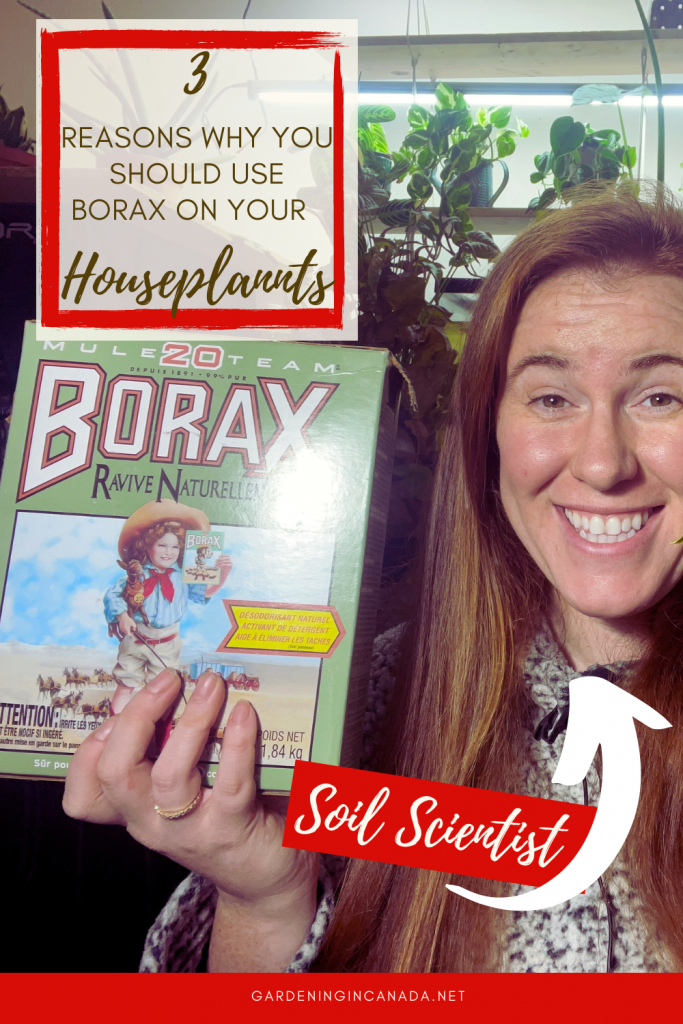- Canada’s Growing Zones Are Changing 2024 - January 12, 2024
- Attracting Wildlife To The Garden - May 16, 2023
- How To Garden Near A Septic Tank - May 9, 2023

How To Use Borax On Houseplants
Using borax on houseplants can yield some amazing results. If you are seeing stunted growth tips and crisp leaves you may have a boron deficiency. This gardening in Canada article looks at how to use borax on houseplants and why the boron contained in borax is so valuable. We will also include a recipe so you can apply your own boron twice yearly.
If you are new to this blog my name is Ashley and I am a soil scientist. I am located in a Canadian Zone 3 and a USDA Zone 4. I write articles, make YouTube videos, Instagram posts all designed for Canadians and Cold Climate gardeners using science-based methods. If you are looking for anything specific be sure to let me know in the comments down below.
If you want to grab the same brand of Borax I use check out this Amazon link here.
What is in borax that makes it useful for plants?
Boron is a micronutrient that is required in very small amounts by all plants. Some plants such as brassica crops have relatively high boron requirements and are therefore most susceptible to boron deficiency. This means using boron in the garden is equally as useful!
What is boron used for in houseplants?
Boron is required for protein synthesis, development of cell walls, carbohydrate metabolism and sugar transport, pollen growth, fruit set, and seed production.
Signs of a boron deficiency in houseplants?
The sign of a boron deficiency is expressed at growing tips of the root or shoot. This means stunting and distortion of the growing tip that can lead to tip death, brittle foliage, and yellowing of lower leaf tips.
The signs of a boron deficiency in houseplants look similar to root rot in many cases. This could be due to the fact that boron is lacking when the roots have been compromised.
How does boron become deficient in houseplants?
Boron is most available for uptake by plants in pH-neutral soils and becomes less available in acidic or alkaline soil. With potting soil, we tend to have more acidic soil and therefore low uptake of micronutrients such as boron. Keep in mind you can purchase pH-neutral potting soils such as this one here.
However, if buying pH-neutral potting soil is not in the budget consider amending your own potting soil using this YouTube Video. In the video, I explain how to use inexpensive amendments to make your own pH-neutral soil. If you want to learn how to make your own potting soil mixture in general using science check out this article here.
Why do you apply borax to houseplants through foliar spray?
Foliar sprays are especially important for those plant species in which boron is immobile; boron uptake from the soil is insufficient to supply these plants’ needs at critical periods of growth and reproductive development. Once incorporated into the applied tissue such as leaves, boron can not be remobilized to supply the needs of other plant tissues.
This means the best time of year to apply boron to houseplants is in the springtime when you start to see new growth and then midsummer. This is the time of year when critical plant growth is taking place. The addition of boron means that the plants will avoid potential malformed or brittle growth.
If you are applying boron to the garden you will want to do this when the flower buds are just forming and again when the fruits begin to form. Both these times are periods of extreme growth and the added boron will be helpful for the plant. Research has shown that foliar sprays of boron applied just prior to and during bud formation and flowering have increased the yields of numerous fruit and grain crops.
Why do we spray boron and foliar feed instead of soil feed?
Boron does not readily move from other parts of the plants to buds and flowers when it is needed for pollen tube growth, pollen production, bloom retention and seed development. Boron is phloem immobile in most plants. New research is starting to prove this is not the case for all plants but it’s relatively new knowledge that is not fully understood.
Recipe for applying Borax to houseplants
The recipe for applying borax to houseplants is simple.
1 tablespoon per gallon of water.
During the biyearly application, you want to make sure you do not apply more than one oz per plant. A good rule of thumb is to lightly mist the plant leaves once.
Over application is possible so be careful when applying this spray. This mixture can be stored in a cool dark space for up to one year, just make sure it is capped to prevent evaporation.
Using borax on houseplants can yield some amazing results. If you are seeing stunted growth tips and crisp leaves you may have a boron deficiency. This gardening in Canada article looked at how to use borax on houseplants and why the boron contained in borax is so valuable. Let me know in the comments if you have used borax as a source of boron for your plants in the past.
